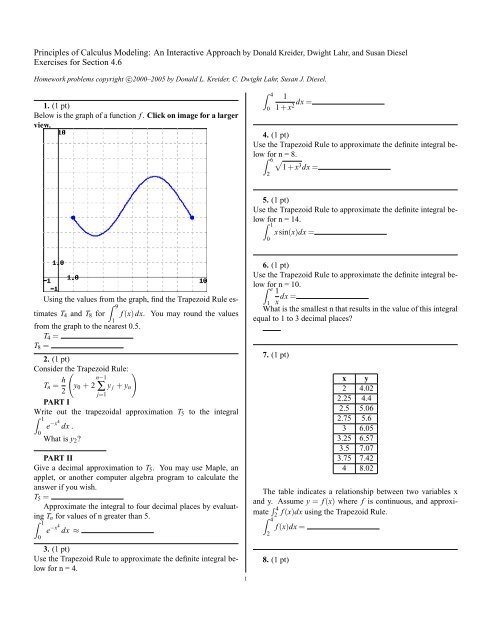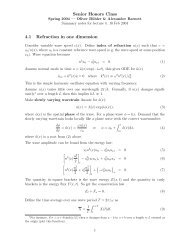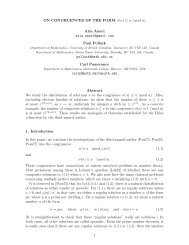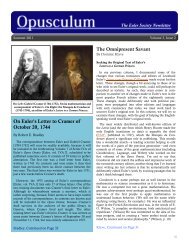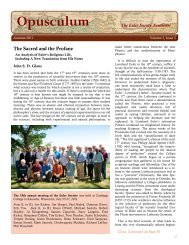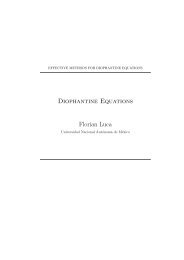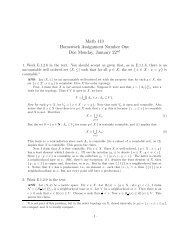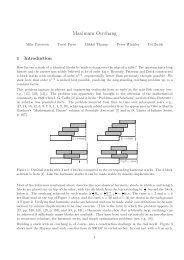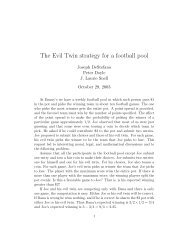Exercises for 4.6 Trapezoid Rule
Exercises for 4.6 Trapezoid Rule
Exercises for 4.6 Trapezoid Rule
Create successful ePaper yourself
Turn your PDF publications into a flip-book with our unique Google optimized e-Paper software.
Principles of Calculus Modeling: An Interactive Approach by Donald Kreider, Dwight Lahr, and Susan Diesel<br />
<strong>Exercises</strong> <strong>for</strong> Section <strong>4.6</strong><br />
Homework problems copyright c○2000–2005 by Donald L. Kreider, C. Dwight Lahr, Susan J. Diesel.<br />
1. (1 pt)<br />
Below is the graph of a function f . Click on image <strong>for</strong> a larger<br />
view.<br />
Using the values from the graph, find the <strong>Trapezoid</strong> <strong>Rule</strong> es-<br />
Z 9<br />
timates T4 and T8 <strong>for</strong><br />
1<br />
from the graph to the nearest 0.5.<br />
T4 =<br />
T8 =<br />
2. (1 pt)<br />
Consider the <strong>Trapezoid</strong> <strong>Rule</strong>:<br />
Tn = h<br />
<br />
<br />
n−1<br />
y0 + 2<br />
2 ∑ y j + yn<br />
j=1<br />
f (x)dx. You may round the values<br />
PART I<br />
Write out the trapezoidal approximation T5 to the integral<br />
Z 1<br />
0<br />
e −x4<br />
dx .<br />
What is y2?<br />
PART II<br />
Give a decimal approximation to T5. You may use Maple, an<br />
applet, or another computer algebra program to calculate the<br />
answer if you wish.<br />
T5 =<br />
Approximate the integral to four decimal places by evaluating<br />
Tn <strong>for</strong> values of n greater than 5.<br />
Z 1<br />
0<br />
e −x4<br />
dx ≈<br />
3. (1 pt)<br />
Use the <strong>Trapezoid</strong> <strong>Rule</strong> to approximate the definite integral below<br />
<strong>for</strong> n = 4.<br />
1<br />
Z 4<br />
0<br />
1<br />
dx =<br />
1 + x2 4. (1 pt)<br />
Use the <strong>Trapezoid</strong> <strong>Rule</strong> to approximate the definite integral be-<br />
low <strong>for</strong> n = 8.<br />
Z 6<br />
2<br />
<br />
1 + x 3 dx =<br />
5. (1 pt)<br />
Use the <strong>Trapezoid</strong> <strong>Rule</strong> to approximate the definite integral below<br />
<strong>for</strong> n = 14.<br />
Z 1<br />
0<br />
xsin(x)dx =<br />
6. (1 pt)<br />
Use the <strong>Trapezoid</strong> <strong>Rule</strong> to approximate the definite integral belowZ<br />
<strong>for</strong> n = 10.<br />
e 1<br />
dx =<br />
1<br />
x<br />
What is the smallest n that results in the value of this integral<br />
equal to 1 to 3 decimal places?<br />
7. (1 pt)<br />
x y<br />
2 4.02<br />
2.25 4.4<br />
2.5 5.06<br />
2.75 5.6<br />
3 6.05<br />
3.25 6.57<br />
3.5 7.07<br />
3.75 7.42<br />
4 8.02<br />
The table indicates a relationship between two variables x<br />
and y. Assume y = f (x) where f is continuous, and approximate<br />
R 4<br />
f (x)dx using the <strong>Trapezoid</strong> <strong>Rule</strong>.<br />
Z 2<br />
4<br />
2<br />
f (x)dx =<br />
8. (1 pt)
x y<br />
0 -0.060<br />
0.1 0.190<br />
0.2 0.299<br />
0.3 0.346<br />
0.4 0.349<br />
0.5 0.389<br />
0.6 0.475<br />
0.7 0.724<br />
0.8 0.737<br />
0.9 0.863<br />
1 0.901<br />
1.1 0.811<br />
1.2 0.842<br />
The table indicates a relationship between two variables x<br />
and y. Assume y = f (x) where f is continuous, and approxi-<br />
mate R 1.2<br />
0 f (x)dx using the <strong>Trapezoid</strong> <strong>Rule</strong>.<br />
Z 1.2<br />
0<br />
f (x)dx =<br />
9. (1 pt)<br />
x y<br />
5 2.74<br />
5.5 2.85<br />
6 1.95<br />
6.5 3.55<br />
7 2.15<br />
7.5 3.74<br />
8 3.33<br />
8.5 3.92<br />
9 2.00<br />
9.5 2.08<br />
10 3.66<br />
The table indicates a relationship between two variables x<br />
and y. Assume y = f (x) where f is continuous, and approxi-<br />
mate R 10<br />
5 f (x)dx using the <strong>Trapezoid</strong> <strong>Rule</strong>.<br />
Z 10<br />
5<br />
f (x)dx =<br />
10. (1 pt)<br />
A map of a pond is shown below.<br />
2<br />
Assume each little square is 10 feet on each side. Use the<br />
<strong>Trapezoid</strong> <strong>Rule</strong> to estimate the area of the pond to the nearest<br />
100 square feet.<br />
Area =<br />
11. (1 pt)<br />
What is the 9th<br />
Z 20 14x<br />
√ dx?<br />
x + 1<br />
subinterval trapezoid approximation of<br />
0<br />
What is the difference (in absolute value) between the approximation<br />
and the exact value of the integral?<br />
12. (1 pt)<br />
What is the difference between the 7th subinterval trapezoid approximation<br />
and the 10th subinterval trapezoid approximation<br />
of<br />
Z 8<br />
−5<br />
x 3 + 3xdx; that is, what is T7 − T10?<br />
13. (1 pt)<br />
Estimate<br />
Z 5<br />
0<br />
x 3 2 dx using 5 trapezoids.<br />
What is the exact value of this integral?<br />
14. (1 pt)<br />
Approximate<br />
Z 11<br />
9<br />
ln(x)dx using 9 trapezoids.<br />
According to the Web site example, what is the maximum<br />
difference between this approximation and the exact value of<br />
the integral?
15. (1 pt)<br />
The trapezoid approximation of an integral is often more accurate<br />
than an equivalent Riemann sum.<br />
Approximate R 15<br />
9 x6 − 23x − 27dx<br />
Using 4 trapezoids:<br />
Using 4 circumscribed rectangles:<br />
What is the exact value of the integral?<br />
16. (1 pt)<br />
Approximate<br />
Z 11<br />
6<br />
x 1/2 dx using 7 trapezoids.<br />
According to the Web site example, what is the maximum<br />
difference between this approximation and the exact value of<br />
the integral?<br />
What is the actual difference (in absolute value) between the<br />
approximation and the exact value of the integral?<br />
17. (1 pt)<br />
Match the integrals to the values of their trapezoid approximations.<br />
1. R 17<br />
4 1 + cos(x)dx, 7 trapezoids<br />
2. R 16<br />
2 x2 + 5x + 9dx, 16 trapezoids<br />
Generated by the WeBWorK system c○WeBWorK Team, Department of Mathematics, University of Rochester<br />
3<br />
3. R 18 √<br />
10 xdx, 9 trapezoids<br />
4. R 11<br />
4<br />
5. R 20<br />
2<br />
ln(x)dx, 9 trapezoids<br />
sin(x) + tan(x)dx, 4 trapezoids<br />
6. R 16<br />
10 ex + xdx, 10 trapezoids<br />
A. 12.8578926740226<br />
B. 2124.31275720165<br />
C. -1015.12261897343<br />
D. 29.82718692231<br />
E. 13.8236654949988<br />
F. 9128502.5952647<br />
18. (1 pt)<br />
Consider R 16<br />
4 ln(x)x 5 2 . Refer to example 3 in this section on the<br />
Web site. Without evaluating the integral or computing a trapezoid<br />
approximation, determine the minimum number of trapezoids<br />
needed to guarantee that the trapezoid approximation of<br />
this integral is within .1 of the real value.<br />
19. (1 pt)<br />
Consider R 10<br />
5 4x . Refer to example 3 in this section on the Web<br />
site. Without evaluating the integral or computing a trapezoid<br />
approximation, determine the number of trapezoids needed to<br />
guarantee that the trapezoid approximation of this integral is<br />
within 10 of the real value.


